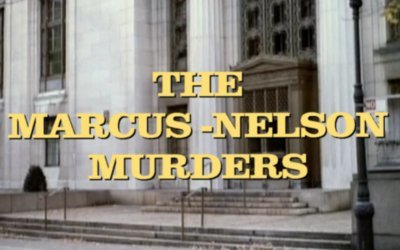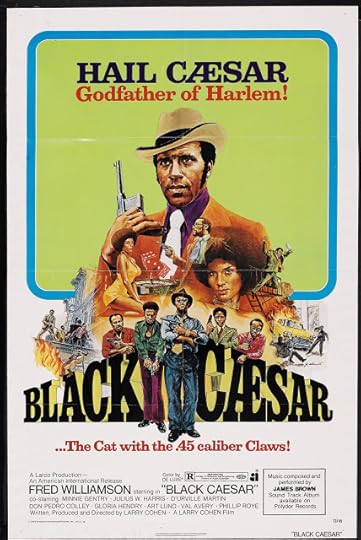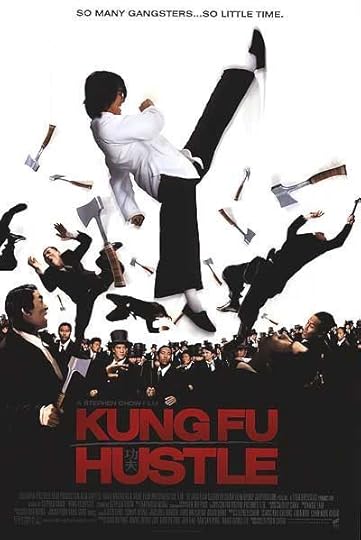Movies I Watched in April, Part 2
Finally, here's part 2 of the April movie recap...

After completing the entire run of my beloved 1970s series “Kojak” (if you follow @willpfeifer on Twitter, you're probably sick of all the Kojak-related tweets), I decided to delve into the TV movies that aired both before and after the series. “The Marcus-Nelson Murders” ran as “The CBS Thursday Night Movie” way back in March 1973, about six months before “Kojak” debuted. The movie is very, very good, but in a slightly different way than the series itself. For one thing, the story is a sprawling tale (based loosely on a true story) about two (white) women who are raped and murdered and the young (black) man who is arrested and railroaded into a confession by corrupt cops. Lt. Theo Kojack (the TV show would drop the “c” from the name) doesn’t even play a big role until the second half of the film. Until then, he skirts around the edge of the case, becoming increasingly suspicious that the prime suspect is not, in fact the one who did it. One of the best things about the TV series “Kojak” was how it combined gritty 1970s crime drama with a certain sardonic sense of humor, mostly thanks to Telly Savalas’ sly performance. “The Marcus-Nelson Murders” is certainly gritty – it feels very much like “The French Connection” or “Serpico” – but it doesn’t have the humor of the show. Kojack is much more driven here, furious about the corruption around him and frustrated by the fact that, in the end, there’s really not much justice to be found. I was surprised how “adult” and downbeat the movie was, in fact, and impressed as well. Hard to see something like this hitting the airwaves today – especially on CBS, home of a dozen or so shows that couldn’t conceive of something as outrageous as police corruption. Keep an eye out for a young Ned Beatty and '70s stalwart Marjoe Gortner. Also, Telly's brother, George Savalas, plays a reporter here, though of course he'd join the cast of "Kojak" as the slovenly, plant loving cop Stavros.

In the last installment, I slammed Larry Cohen’s “The Stuff,” a boring, unimaginative film that wasted the potential of its premise. But thankfully, I watched another (and earlier) Cohen film in April that delivered all the thrills its premise promised, his 1973 crime thriller “Black Caesar.” The idea is beyond simple: Take the classic gangster movie template of the 1930s Warner Bros. movies, like “Little Caesar” and “The Public Enemy,” and update it for the (then) modern Blaxploitation era. Fred “The Hammer” Williamson stars as Tommy Gibbs, a poor ghetto kid who climbs the ranks of crimedom in Harlem. Like I said, it’s the standard gangster plot, but having the lead character be a black man adds an element of rage and injustice that throws some additional gasoline on the fire, and Williamson makes the most of it. He’s beyond ruthless – he really enjoys turning the tables on the Italian gangsters and corrupt cops who stand in his way. (The final scene between him and his nemesis, a nightmarish Irish cop played by Art Lund, involves humiliation, shoe polish and tables being turned in a way I’ve never seen in any movie.) Naturally, as with the classic gangster movies, Gibbs eventually falls from grace, and the scenes of him stumbling around New York City mortally wounded, are surprisingly powerful. Cohen apparently filmed them without a permit, and the reaction of the shocked bystanders was genuine. Now that’s how you make a movie!

Allie and I watched this one (I showed it to her without realizing it’s actually rated R, though I’m not sure why it earned that rating), and it reinforced my opinion that it’s one of the most purely fun movies of the 21stcentury. From the opening moments, where the villainous Axe Gang takes the streets in an elaborate dance number to the final shots, which hint that the whole thing is going to start all over again, writer/director/star Stephen Chow packs every frame with imagination, action and heart. It really is a live-action cartoon, using CGI to contort the actors’ bodies and faces like they’re Warner Bros. characters, running like the Roadrunner or getting twisted like Daffy Duck. But it’s not all goofy laughs. There are moments of surprising poetry and grace sprinkled throughout, such as the shot of the Axe Gang members suspended in the air like a Magritte painting. Best of all, the finale battle ends with our formerly goofy hero achieving a sort of transcendent grace and the big villain kneeling before him, eager to learn and change. It’s quite a finale that somehow, strangely, perfectly fits with what’s come before.

After completing the entire run of my beloved 1970s series “Kojak” (if you follow @willpfeifer on Twitter, you're probably sick of all the Kojak-related tweets), I decided to delve into the TV movies that aired both before and after the series. “The Marcus-Nelson Murders” ran as “The CBS Thursday Night Movie” way back in March 1973, about six months before “Kojak” debuted. The movie is very, very good, but in a slightly different way than the series itself. For one thing, the story is a sprawling tale (based loosely on a true story) about two (white) women who are raped and murdered and the young (black) man who is arrested and railroaded into a confession by corrupt cops. Lt. Theo Kojack (the TV show would drop the “c” from the name) doesn’t even play a big role until the second half of the film. Until then, he skirts around the edge of the case, becoming increasingly suspicious that the prime suspect is not, in fact the one who did it. One of the best things about the TV series “Kojak” was how it combined gritty 1970s crime drama with a certain sardonic sense of humor, mostly thanks to Telly Savalas’ sly performance. “The Marcus-Nelson Murders” is certainly gritty – it feels very much like “The French Connection” or “Serpico” – but it doesn’t have the humor of the show. Kojack is much more driven here, furious about the corruption around him and frustrated by the fact that, in the end, there’s really not much justice to be found. I was surprised how “adult” and downbeat the movie was, in fact, and impressed as well. Hard to see something like this hitting the airwaves today – especially on CBS, home of a dozen or so shows that couldn’t conceive of something as outrageous as police corruption. Keep an eye out for a young Ned Beatty and '70s stalwart Marjoe Gortner. Also, Telly's brother, George Savalas, plays a reporter here, though of course he'd join the cast of "Kojak" as the slovenly, plant loving cop Stavros.

In the last installment, I slammed Larry Cohen’s “The Stuff,” a boring, unimaginative film that wasted the potential of its premise. But thankfully, I watched another (and earlier) Cohen film in April that delivered all the thrills its premise promised, his 1973 crime thriller “Black Caesar.” The idea is beyond simple: Take the classic gangster movie template of the 1930s Warner Bros. movies, like “Little Caesar” and “The Public Enemy,” and update it for the (then) modern Blaxploitation era. Fred “The Hammer” Williamson stars as Tommy Gibbs, a poor ghetto kid who climbs the ranks of crimedom in Harlem. Like I said, it’s the standard gangster plot, but having the lead character be a black man adds an element of rage and injustice that throws some additional gasoline on the fire, and Williamson makes the most of it. He’s beyond ruthless – he really enjoys turning the tables on the Italian gangsters and corrupt cops who stand in his way. (The final scene between him and his nemesis, a nightmarish Irish cop played by Art Lund, involves humiliation, shoe polish and tables being turned in a way I’ve never seen in any movie.) Naturally, as with the classic gangster movies, Gibbs eventually falls from grace, and the scenes of him stumbling around New York City mortally wounded, are surprisingly powerful. Cohen apparently filmed them without a permit, and the reaction of the shocked bystanders was genuine. Now that’s how you make a movie!

Allie and I watched this one (I showed it to her without realizing it’s actually rated R, though I’m not sure why it earned that rating), and it reinforced my opinion that it’s one of the most purely fun movies of the 21stcentury. From the opening moments, where the villainous Axe Gang takes the streets in an elaborate dance number to the final shots, which hint that the whole thing is going to start all over again, writer/director/star Stephen Chow packs every frame with imagination, action and heart. It really is a live-action cartoon, using CGI to contort the actors’ bodies and faces like they’re Warner Bros. characters, running like the Roadrunner or getting twisted like Daffy Duck. But it’s not all goofy laughs. There are moments of surprising poetry and grace sprinkled throughout, such as the shot of the Axe Gang members suspended in the air like a Magritte painting. Best of all, the finale battle ends with our formerly goofy hero achieving a sort of transcendent grace and the big villain kneeling before him, eager to learn and change. It’s quite a finale that somehow, strangely, perfectly fits with what’s come before.
Published on May 22, 2017 17:45
No comments have been added yet.
Will Pfeifer's Blog
- Will Pfeifer's profile
- 23 followers
Will Pfeifer isn't a Goodreads Author
(yet),
but they
do have a blog,
so here are some recent posts imported from
their feed.



